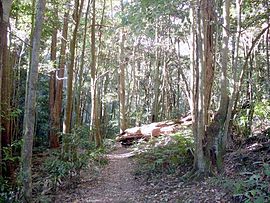Macquarie Pass National Park
|
Macquarie Pass National Park New South Wales |
|
|---|---|
|
IUCN category II (national park)
|
|

Rainforest in the park
|
|
| Coordinates | 34°34′10″S 150°39′25″E / 34.56944°S 150.65694°ECoordinates: 34°34′10″S 150°39′25″E / 34.56944°S 150.65694°E |
| Established | 3 December 1969 |
| Area | 11 km2 (4.2 sq mi) |
| Managing authorities | National Parks and Wildlife Service (New South Wales) |
| See also | Protected areas of New South Wales |
Macquarie Pass National Park is a national park in New South Wales, Australia, 90 km southwest of Sydney. It is located around the pass of the same name, which is on the Illawarra Highway and part of the Illawarra escarpment.
Macquarie Pass National Park was established in 1970 and protects a range of eucalypt forests and rainforest, including one of Australia's most southerly stands of subtropical rainforest. The pass was opened in 1898. It has been a major route into and out of the Illawarra coastal plain ever since. There is a major power line running east–west through the park.
As well as a diverse array of birdlife the park has swamp wallabies and wombats.
The area was heavily logged for cedar in the first half of the 19th century.
Picnic facilities are provided at two sites at the bottom of Macquarie Pass. Barbecues are provided at two other picnic areas.
The Macquarie Rivulet track is two kilometres long and easy to medium grade. A track goes along 30 metres to a parking area near a picnic area and rivulet. An old track continues on along the north side of the rivulet which is flat for several hundred metres, then becomes steeper, dropping back to the rivulet by a large boulder. Birds which may be seen here include dollarbird, azure kingfisher, sacred kingfisher, golden whistler, yellow-throated scrubwren, black-faced monarch and rufous fantail.
The Cascade Falls Walk is a one kilometre track, easy grade. It goes beside Cascade Creek at the base of Macquarie Pass to a small waterfall. Birds found here include green catbird, rose robin, red-browed finch, yellow-throated scrubwren, brown gerygone, Lewin's honeyeater, crimson rosella. Fungi are apparent here.
...
Wikipedia

